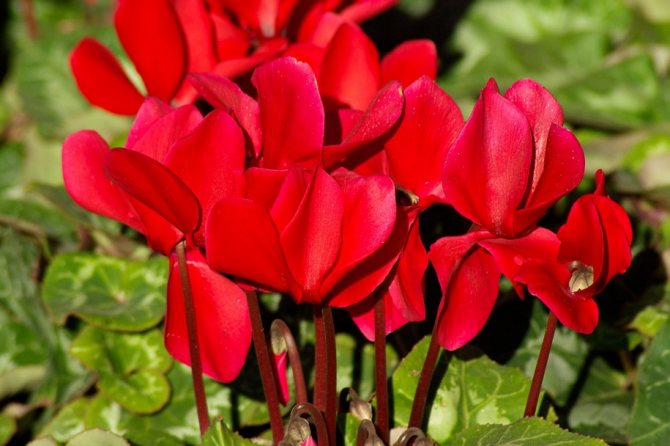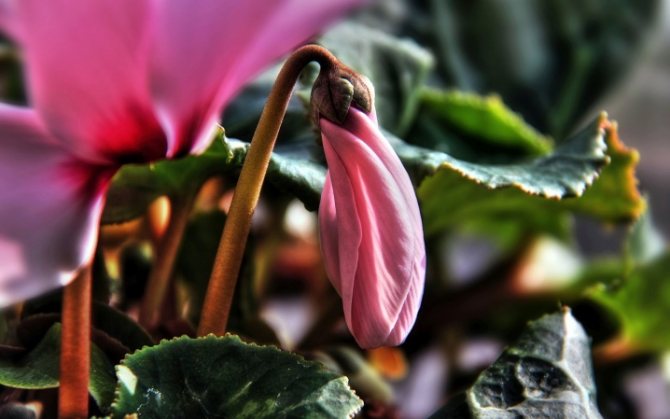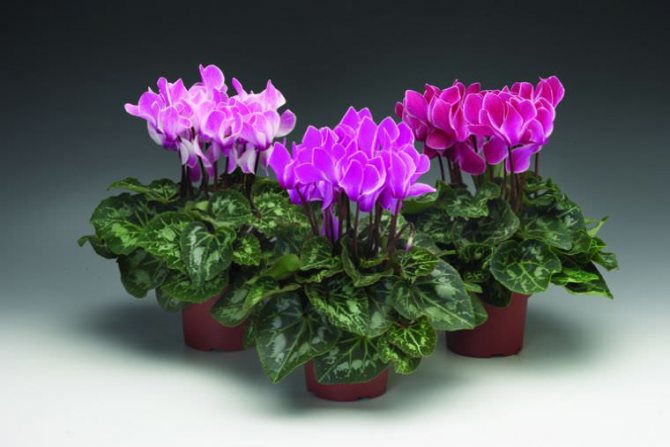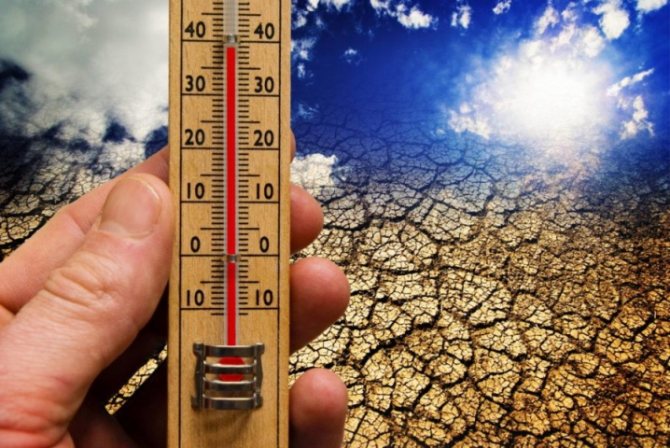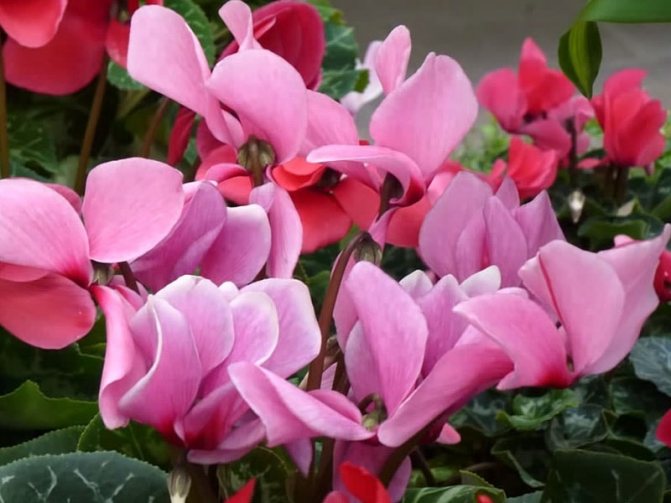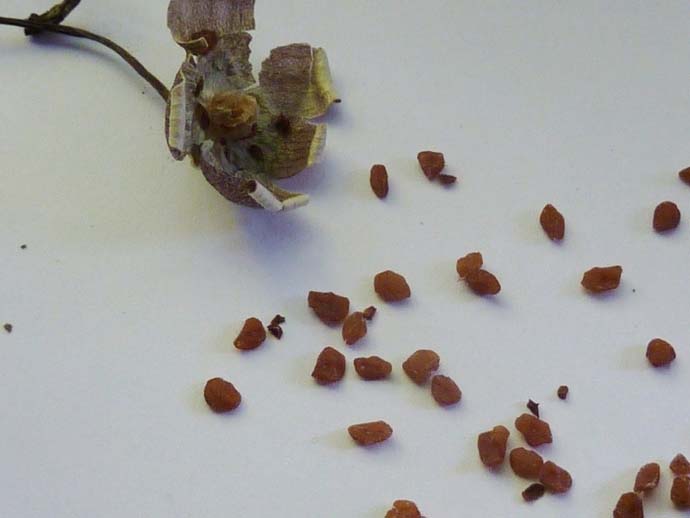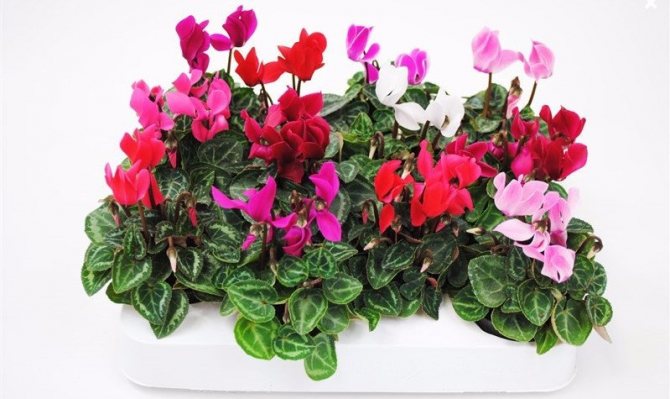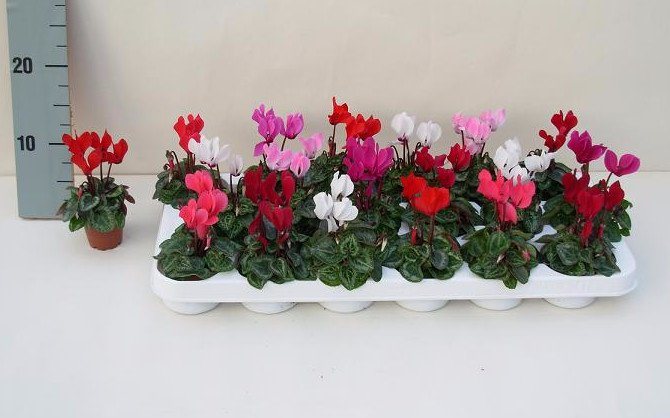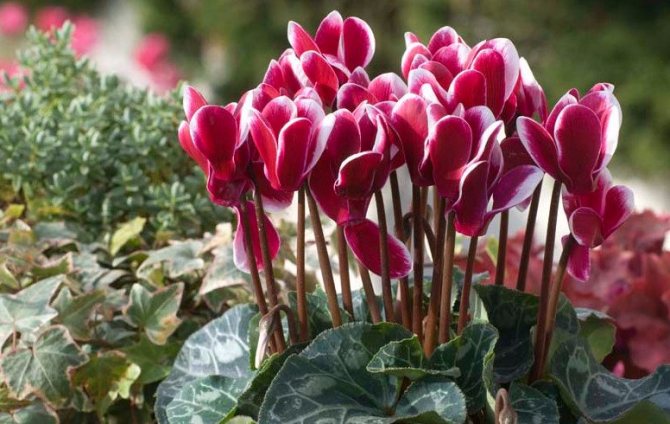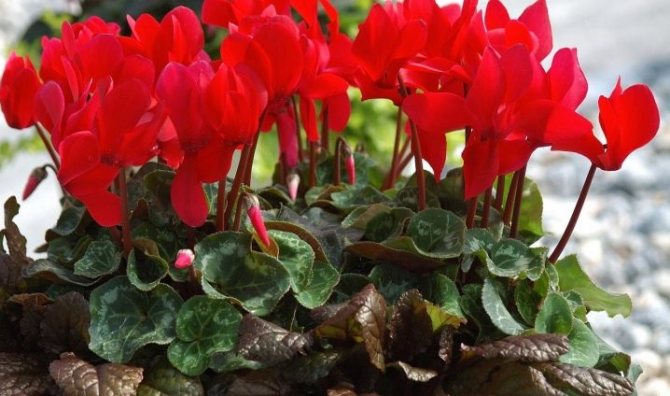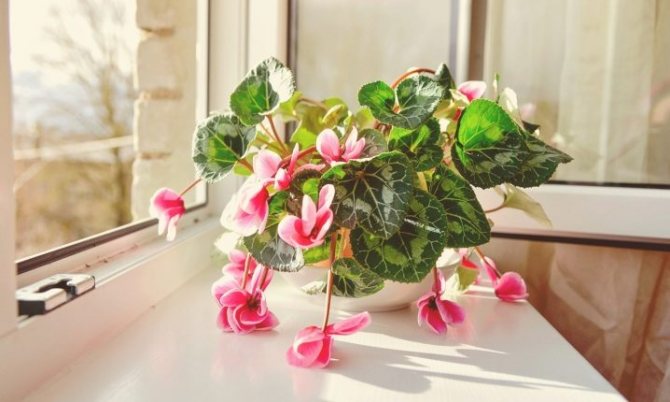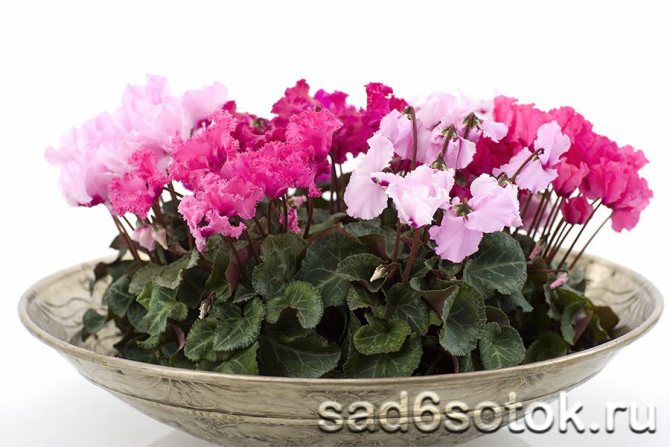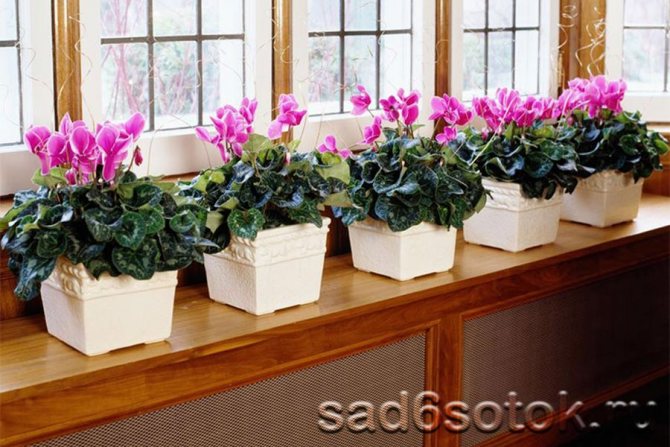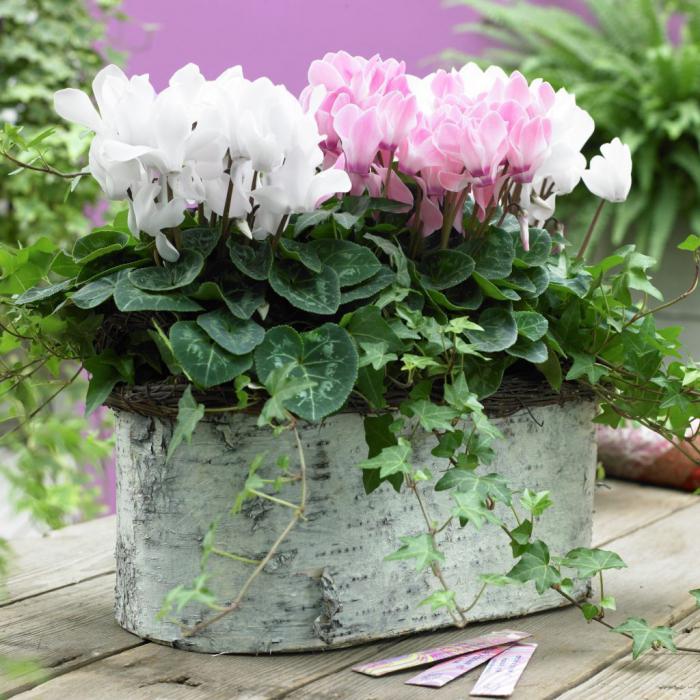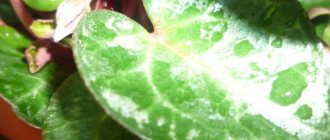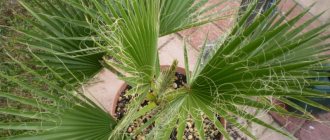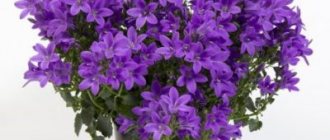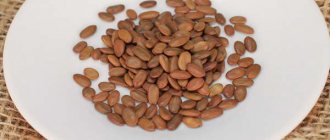Types and interesting varieties of cyclamen
Cyclamen is not subject to changeable fashion. Today, just like a hundred years ago, it grows on our windowsills, balconies and pleases with lush flowering. Its popularity is confirmed by statistics - more than 150 million cyclamens are grown in European countries.
Cyclamen is a perennial herb. In nature, different species can be found in the forests and mountains of southern Europe, on the Mediterranean islands, in the foothills of the Caucasus and in the hot countries of the Middle East and North Africa. Over the centuries, the cyclamen has adapted to the climate of its native places. The life cycle of a plant is divided into two stages: vegetation and dormancy. In summer, in the heat, most cyclamens rest, shedding leaves and accumulating moisture in the tubers. A new phase of growth and flowering begins in autumn.
The plant got its name from the shape of the tuber. Translated from Greek, it means "circle". The petiolate leaves and peduncles of the cyclamen begin to grow from the tubers. The flowers are single, beautifully curved, like fluttering butterflies. The color of the flowers is varied: crimson, bright red, white, pink. The foliage is also decorative, with a silvery pattern on top similar to frosty patterns. Many species have a pleasant aroma.
More than 20 plant species are known and described, but at home the most common are Persian cyclamen, European cyclamen (purple), ivy-leaved cyclamen (Neapolitan), Kos cyclamen.
How to grow a cyclamen on your own, as well as advice on care, you will find in the article "Cyclamen".
Reasons why you need a transplant
A transplant may be needed in the following cases:
- It is worth replanting a flower if its tuber takes up a lot of space in the pot and the roots have nowhere to grow.
- It is also needed after purchase, but not immediately, but after several months. The pots in which the flower is sold are too small, so you need to choose a larger container so that the root system continues to develop unhindered. Read about the rules for caring for a cyclamen after purchase in our article.
- If the flower was bought, then you need to know that the land in which it grows is very poor. Immediately after the cyclamen fades, it is transplanted. In the case of good soil in a purchased pot, the plant can not be touched for a whole year.
- Experienced flower growers recommend transplanting regularly. This should be done once every few years.
Necessary conditions for growing
Due to the fact that special cyclamen hybrids have been developed for growing in indoor conditions, this greatly facilitates flower care. But in order to achieve long and abundant flowering, you must follow the rules that will help you grow a healthy and beautiful plant.
We recommend that you familiarize yourself with the list of the best indoor plants for the bedroom, nursery and office, as well as with a list of unpretentious and dangerous flowers.
Temperature and humidity
Persian cyclamen prefers to be in an environment whose temperature not higher than 17 ° C in winter - that is, during flowering. During dormancy (summer), the flower will feel normal at a temperature up to 25 ° C.
The humidity in the room should be average, the lack of moisture is bad for the plant, so take care of maintaining a humid microclimate. To do this, spray the air next to the flower or place a tray with a drainage component under the pot and moisten the drainage periodically.
Grow lighting
The plant does not like direct sunlight (burns are possible), but prefers bright, but diffused lighting.
Important! If the plant is deprived of light, the leaves will turn yellow.
On the east window, the flower will receive the required amount of light in the summer, and in the winter you can move it to the south window.
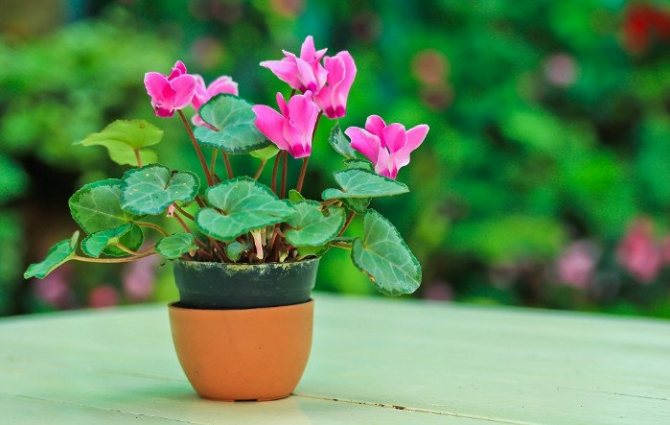
Air quality
Persian cyclamen grows normally only in clean air... Gas fumes or tobacco smoke are contraindicated for him. The room in which the cyclamen is located must be frequently ventilated so that the air does not stagnate.
Also, flower pots should be placed at a sufficient distance from each other so that they are ventilated from all sides and rot does not form. But when ventilating, make sure that the plant is not in a draft.
When to carry out the procedure?
Important! Transplantation is carried out after the plant leaves the dormant period, that is, in late July or early August. This procedure must be done before the buds appear.
The end of the dormant period can be determined by the formation of young leaves.
The transplant time also depends on the type of cyclamen. For example, the European cyclamen does not have a pronounced state of dormancy and is always green. It begins to bloom in mid or late May. If you do a transplant, then until then. It is best to carry out the procedure in March.
It is completely different to behave with the Persian cyclamen. He experiences a state of calm every year. It comes in the middle of winter and lasts until the end of summer. In the month of June and August, young leaves begin to hatch, it is during this period that transplantation should be done.
A little about the plant
A bright flower with delicate bizarre petals is cyclamen, a perennial tuberous plant of the primrose family. Delicate pink, lilac, burgundy or snow-white - it is a real find for lovers of flowering plants. A big plus is that cyclamen is unpretentious, is not afraid of cold weather and does not need a long day of light, since in the wild it grows in rather harsh conditions. Therefore, a cool windowsill and regular watering are all that he requires of you. Another name for cyclamen is alpine violet, but again it can be credited with the fact that cyclamen suffers from diseases and pests less often than traditional violets. Therefore, it is definitely worth taking on the cultivation of cyclamen. There are tens of shades of cyclamen.
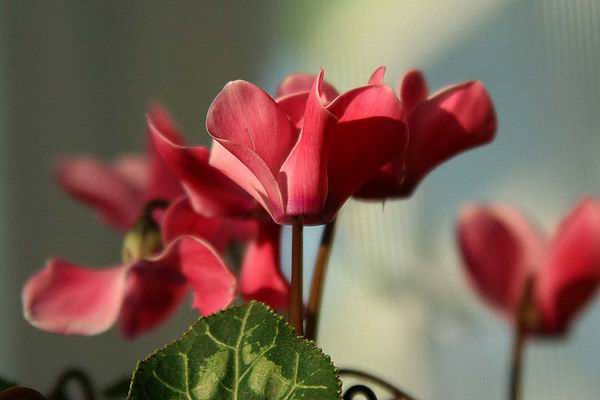

Cyclamen is a perennial flowering plant for your home
There are two options: buy a ready-made plant from the store, or try to grow it from seeds yourself. The second method will require more effort from you, but it will also increase the likelihood that the plant will take root and will delight you with flowering for more than one season. Keep in mind that adapting a store plant for the home is also a whole science. And a flower grown with its own hands from seeds will literally feel at home, since it will ideally fit into the living conditions.
It is possible and necessary to grow cyclamen at home: it will not require any special efforts on your part. One has only to be patient, since the period of germination, first shoots, transplanting seedlings and the formation of an individual plant will drag on for about six months.
The color, size, doubleness of the flower depends on its variety. Suitable for home cultivation:
- European cyclamen - has pink medium-sized flowers with a pleasant smell; less popular with home growers.
- Persian cyclamen - has many varieties (Scarlet Moth, Charlie, Sylphide, Topaz, Flamingo, etc.), each of which differs in shade, size or shape of the flower.
Important! Some varieties of the Persian cyclamen, for example, Barbarossa, differ in toughness and require preliminary contrasting heat treatment before sowing.
Photo gallery: varieties of cyclamen


Cyclamen Victoria
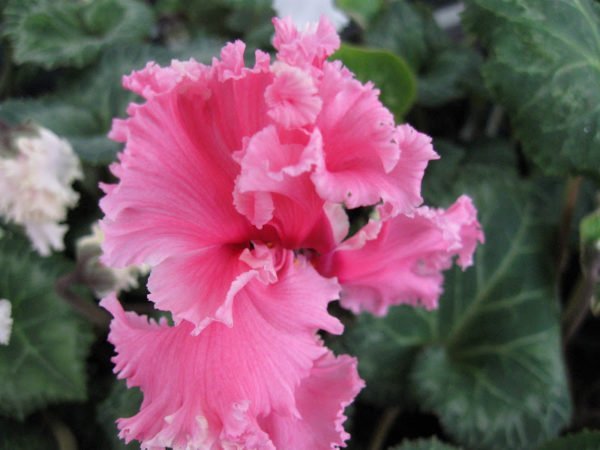

Rococo Rose


Cyclamen Flamingo


Charlie
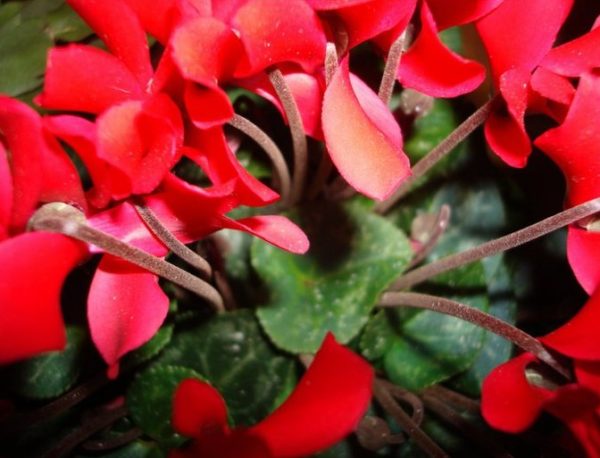

Cyclamen Scarlet Moth
Photo
Next, you can see the photo of the flower:
Can this be done with a flowering plant?
Transplanting at the time of flowering leads to the fall of the buds, because during a change of soil, the flower is stressed. This causes flowering and growth to stop. An exception can only be those cyclamens that were purchased in the store and then not immediately, but after the flower gets used to a new place. They need to be transplanted from store soil into fresh soil.
Next, you can see the photo of the flower:
Preparing for the procedure
Tank size
Cyclamen does not feel well in large pots. The capacity is selected taking into account the size of the plant rhizome:
- A pot with a diameter of 7-8 centimeters is perfect for a young tuber from one to one and a half years old.
- Older tubers (2-3 years old) need containers with a diameter of 15-16 centimeters.
Reference. The distance from the tuber to the edge of the pot should be 2-3 centimeters.
Priming
A lot depends on the soil, especially the state of the cyclamen itself, the activity of growth and flowering. Ideally the soil mixture for cyclamen should be loose and nutritious. Looseness of the soil is the main condition for the successful growth of a flower. Often they buy a ready-made mixture in flower shops. But it's better to do it yourself. For this you will need:
- One piece of peat.
- Humus one part.
- Clean sand, also one piece.
- Leafy land - three parts.
In order for the roots to form better, and the plant to take root better, a little vermiculite is added to the ground. Before planting, the soil must be watered with a weak solution of potassium permanganate with potassium. Such a procedure is needed to kill fungal pathogens.
What it is?
There are also undersized varieties. The leaves are round-cordate on dark pink petioles, the color of the leaf surface is from dark green to silvery with green. The flowers are five-petalled, radial, folded like the wings of a butterfly, simple and double, one-color and two-color, and even in the form of a bell.
The color of the flowers is different, mainly red and pink, as well as white and purple. More than 20 plant species are cultivated: Cypriot, Neapolitan, European, Kos, Cretan, Persian, African, Colchis, ivy and others (you can learn how to care for Persian cyclamen at home here). In our flower shops you can find European and Persian cyclamen.
Process instructions step by step
How to transplant a home cyclamen into another pot - step by step:


Prepare the substrate.- Prepare a new container, if the old one will be used, then be sure to treat it with potassium permanganate, or pour boiling water over it, this is done for disinfection.
- Carefully remove yellowed and dry leaves.
- Carefully remove the plant from the pot and examine the bulb and roots.
- Dry and rotten roots should be trimmed with clean scissors.
- Since the transplantation is carried out in new fresh soil, it is necessary to shake off the old soil from the roots as much as possible.
- Next, drainage is poured onto the bottom of the pot and 3-4 centimeters soil is added.
- Put the flower and fill up the earth, but you should not fill up the whole bulb. It should be visible.
- Thoroughly water the cyclamen, while not getting water on the center of the tuber. Drain excess water from the pan.
- Then the flower is put back in place and left alone.
Interesting Facts
This flower has several names.Some of them sound funny: dryak or pork bread (because pigs love to feast on cyclamen tubers) - but the Alpine violet is quite consistent with its gentle character. The name is pronounced correctly with an emphasis on the first syllable: cyclamen, but the people have taken root in the French style.
Cyclamen can adapt to higher room temperatures by increasing humidity... Since spraying is not always possible, you can get out of the situation by placing containers filled with wet expanded clay next to the flowers.
If you find an error, please select a piece of text and press Ctrl + Enter.
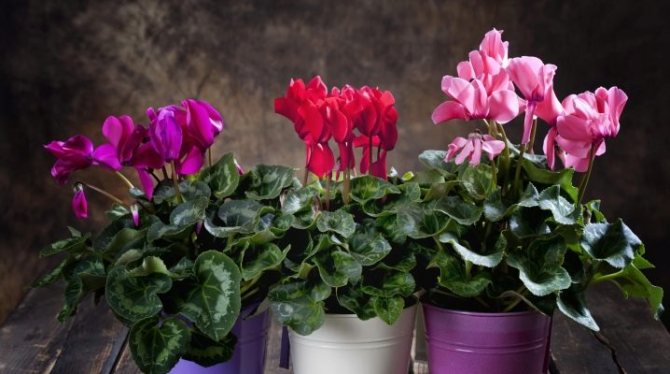

The blooming cyclamen bewitches our eyes with its original shape and bright color. This indoor flower, which is also called the alpine violet, makes almost every grower want to have it in their collection. The flower has a peculiarity - its flowering period falls on the winter months.


Cyclamen belongs to the Primroses family. The countries of the Mediterranean coast are considered the homeland of the flower; the plant is common in Iran, in Iraq. On the African continent, cyclamen grows in its northern and eastern territories, and on our mainland, the plant can be found on the Black Sea coast. In our country, wild cyclamens are listed in the nature conservation Red Book.
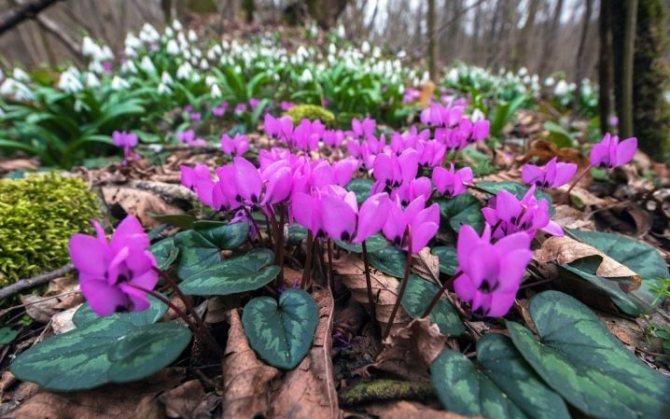

How to divide a flower correctly?
On a note. Separation of a flower can be done in two ways - tubers and rosettes.
Tubers:
- The first step is to get the onion and dry it.
- After, cut into pieces and at the same time leave a bud and several roots at each of their parts.
- Then we leave it in a dark place to dry the cut.
- When the tuber is planted, the pot is removed away from direct rays.
Sockets:
- To begin with, a shoot comes off from the tuber and is planted in damp ground.
- Next, place the flower under the transparent film.
- After a few weeks, the rosettes will appear at the outlets.
- Be sure to observe the temperature regime.
- Follow-up care is no different from caring for an adult flower.
More details about these and other methods of cyclamen propagation are discussed in a separate article.
Reproduction of Persian cyclamen
Cyclamen can be propagated in two ways: by seeds and by dividing the tuber. Step-by-step instructions for germinating seeds can be found above. Tuber division is carried out during plant transplant and is considered too difficult and unreliable, especially for beginners. Such an operation is so often unsuccessful that it is believed that the only way to multiply the Persian cyclamen is to sow and germinate seeds.
Care
Basic requirements and rules for caring for a cyclamen at home:


Lighting and temperature. Cyclamen has a positive attitude towards coolness and bright diffused light. There is no need to put the cyclamen under the scorching sun. It will feel best on the west or east side. Suitable temperature + 10 + 18 degrees.- Watering. During the growth period, the soil should be sufficiently moist, but do not overfill the flower with water.
Must rememberthat moist air is good for cyclamen.Immediately after transplanting, you do not need to fill the flower abundantly, you need to do everything as always.
- Top dressing produced no earlier than a month after the flower was transplanted. He needs time to adapt. Moreover, the soil that has been prepared for transplantation and so contains humus, which is a natural fertilizer.
Cyclamen ivy (Neapolitan)
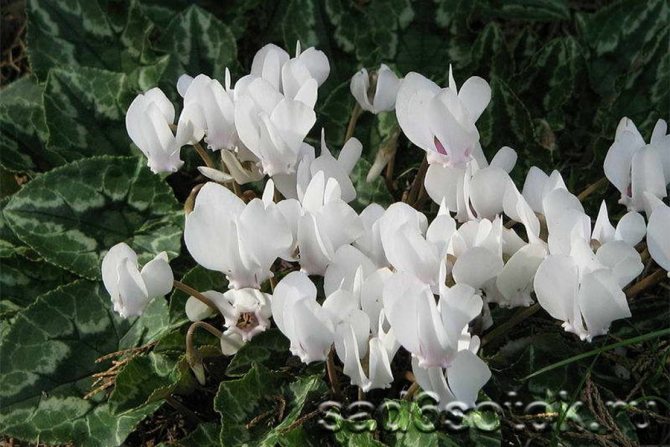

Cyclamen ivy
It grows in forests and on mountain slopes in many countries of southern Europe and western Turkey. In Western Europe, it is considered the easiest to grow and the most frost-resistant. But for growing in the open ground of central Russia, it is not suitable.It has white or pale pink flowers with a purple tint at the base of the petals. Leaves can be of different shapes, round or narrow pointed, and different colors - from dark to bright green with a silvery pattern. Ivy-leaved cyclamen blooms from late August to November.
Popular varieties
Cyclamen leaves "White cover" decorative and shaped like ivy leaves. It blooms in the fall in the second year after sowing. Forms a neat bush 25 cm high. White flowers smell nice.
Plants have varieties "Pink veil" serrated leaves with a clear silvery pattern. Autumn bloom, lush and spectacular. The flowers are soft pink.
Diseases and pests
Cyclamens are not too prone to infectious diseases. If you create all the necessary conditions, the plant will never get sick. But sometimes cyclamens infect ticks. In this case, the leaves become deformed, and the peduncles become crooked. It is difficult to detect pests in the initial stages. And in advanced cases, drugs do not always cope with the destruction of ticks.
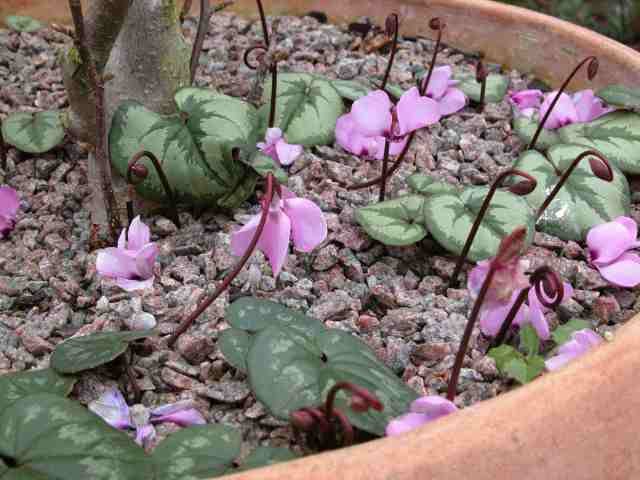

Sometimes the leaves of plants turn yellow and wither. This suggests that the cyclamen is hot, and the air in the room is too dry. Another reason can be too bright light. Sometimes this happens due to insufficient watering.
Decay of peduncles and foliage indicates overflow or ingress of moisture onto the bulb. Cyclamens fade too quickly if the room is too hot or the plant lacks nutrients. In this case, the pot must be moved to a cooler room.
Cyclamens can be damaged by various types of rot. Thrips and aphids are dangerous for the plant. Any damage to the foliage indicates the presence of pests.
Why don't cyclamens bloom?
Sometimes beginner growers cannot achieve flowering. If you want to get a flowering plant in the winter, you need to give it a chance to rest in the summer. Very often, housewives see that the cyclamen does not lose foliage and continue to water it. In response, the flower continues to grow green mass.


At the same time, the bulb is depleted. Therefore, such a plant will never bloom in winter. But it is also not worth overdrying the onion. This can lead to late activity in the winter. Cyclamens bloom in a humid and cool place.
Air humidity requirements
The plant feels good only in high humidity conditions. Therefore, in the process of growing cyclamen in a pot at home, it is important to create the necessary level of moisture. During the period of active growth, foliage spraying can be arranged. Such procedures can be performed only before flowering begins. In the future, you can create a water mist around the plant. Potted cyclamen can be placed in a drip tray with wet gravel. In winter, it is necessary to keep the plant from batteries.
What is necessary?
To transplant a purchased plant into another pot, you should prepare everything you need in advance.
- Landing capacity. You can choose a pot made of plastic or ceramic, as long as it is not too large and has a good drainage hole. Cyclamen loves a tight container, so we choose a new pot 2-4 centimeters larger than the previous one. The new pot must have a tray to collect excess moisture.
- Soil for planting. You can use any soil that is intended for decorative flowering plants. Cyclamen loves when the soil is loose and rich in organic matter. For a plant, choose slightly acidic soils, the optimum acidity is 5.0-6.5 pH.
- Baking powder for soil. It is necessary to add loosening components to the soil. To do this, you can take vermiculite, coarse river sand, coconut fiber, chopped pine bark.
- Drainage material. Fine expanded clay and gravel are used as drainage.
- Fertilizers. After transplanting, the cyclamen can not be fertilized for 1-2 months, since it will take useful trace elements from the soil. After this time, you need to stock up on fertilizer. It can be a liquid fertilizer for decorative flowering plants of the FORTE trademark, the drug Cyclamen, Agricola.
- Means of protection. Cyclamen is a poisonous plant and precautions must be taken when working with it. To perform a flower transplant, you will need a pair of rubber gloves.
How is it different from the European one?
Persian cyclamen is not the only type of cyclamen genus. Another popular variety is the European cyclamen. Despite the fact that both, in their essence, belong to the same family and genus, they have a number of differences. Let's consider them in more detail.
First of all, the Persian cyclamen from the European cyclamen can be distinguished by the appearance of the leaves, in particular, by their color. The leaves of the Persian variety are green in color, while the leaves of the European variety are anthocyanin-colored.


The second feature, thanks to which it is possible to distinguish one or another cyclamen - this is the location of the tuber... So, it has been scientifically proven that in a Persian plant, the tuber is at two levels: most of it is hidden in the soil, but at the same time, a small area can be seen on the surface. The tuber of the European flower is completely submerged in the soil, therefore it is impossible to notice it with the naked eye.
The periods of flowering of plants also differ. As mentioned above, the Persian cyclamen blooms in winter and autumn, and the European one in spring and summer. Moreover, it is worth paying attention to the dimensions of the flowers themselves - they are much smaller in the European variety.
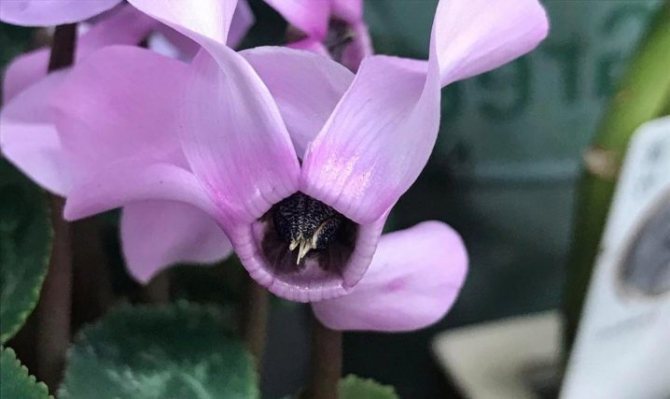

Among other things, you should pay attention to the level of endurance of the flower. So, it is believed that the European variety tends to tolerate room temperature better than the Persian. The latter, in turn, prefers lower temperatures.
And the last distinguishing feature - rest cycle. In this regard, the varieties of cyclamen are quite different. So, the European type practically does not fall into a state of rest. At the same time, after the flowering period, the Persian cyclamen goes into a real hibernation: its leaves can turn yellow and fall off.


The subtleties of planting in a pot
- It is recommended to transplant cyclamens directly with a clod of earth, without disturbing the roots.
- It is useful to pour expanded clay on the bottom of the drainage pot, then a layer of soil mixture is laid. After that, the tuber is lowered into the pot together with a lump of earth and the soil is poured so much that the tuber remains 1 \ 3 sticking out above the ground. After planting, the soil is squeezed with hands.
- Thirty days after transplantation, the cyclamen requires feeding. Ready-made liquid mixtures are best suited for this.
- During flowering, it is useful to feed cyclamens regularly: once a month (until they bloom).
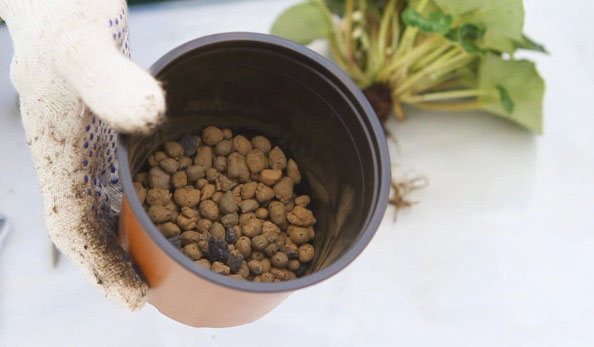

Can blooming cyclamen be transplanted?
During flowering, it is not recommended to transplant flowers at all. That is, it is better not to transplant a flowering cyclamen, if the situation permits. A transplant for a plant is always stressful. Due to the transplant, buds and flowers may crumble. You should also not disturb the plant in a state of stress (new climatic conditions) or disease (if it is not a root disease). Take a closer look at the flower: if it blooms well, has dense leaves (even if it has a bulb with a pot), then the plant feels great.
Persian cyclamens (this type is most often sold in stores) bloom in autumn and winter, until the end of March. At that time blooming cyclamen better not to touch. But when it blooms (at the end of March) - can start the transplant.
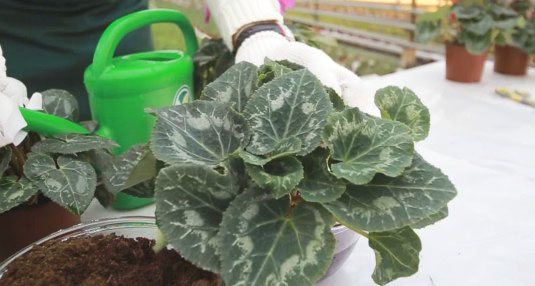

Features of the
By its botanical nature, Persian cyclamen is a tuberous flower.But it is also important to note that it belongs to the myrsin family, is a herbaceous and perennial plant. It is believed that with careful care and if all recommendations for the maintenance of Persian cyclamen are followed, it can live up to 25 years.
Initially, this flower is native to the territory of the Eastern Mediterranean. However, today cyclamen in natural conditions can also be found on the territory of the Russian Federation, in particular, in Krasnodar, Crimea.


The flower is rather small in size. So, despite the fact that it reaches 30 centimeters in height, 20- and 15-centimeter specimens are better known. The shape of cyclamen tubers is oval, slightly flattened from the sides. If we talk about the leaves of the plant, they have an unusual and original shape that resembles a heart, and in size they can reach 14 centimeters (when assembled into a socket). The leaves themselves are green in color, but the petioles are colored reddish. In addition, silvery streaks can be observed on the sheets themselves.
Placed chaotically, such veins create an intricate pattern on the surface of the leaf, which gives an original appearance to the entire plant.
As for the flowers themselves, they all consist of a clearly defined number of petals - 5 pieces. The flowers can be up to 5 centimeters in diameter.... Due to the unusual shape of the flower, which is achieved due to the fact that one of the petals bends back, the flower is often compared to a butterfly. The color palette is also quite varied. So, you can find the whole gamut of shades from completely white to red or even purple.
Watering
It is very important to organize the correct watering of the cyclamen in the pot. At home, caring for a plant is not difficult. However, flower growers often have difficulties with watering. The plant is very moody. Excess moisture and lack of moisture can harm him. Therefore, watering should be such that there is no overflow or drying out of the earthy coma. You need to know that the European cyclamen is watered all year round. But Persian plants need to be watered less often during the dormant period.
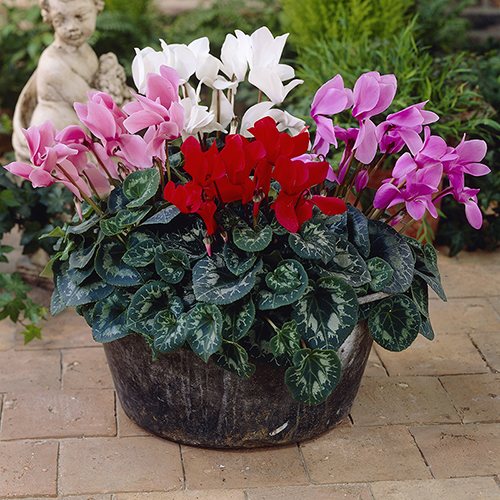

Regular watering of cyclamen is required during the period of active growth. To know for sure that the plant has enough water, it is necessary to use the bottom irrigation method. Cyclamen with a pot is immersed in a container of water and wait until the top layer of soil gets wet. Then the plant should be removed and allowed to drain off excess liquid. This method of watering is very convenient, since it avoids moisture ingress on the surface of the tuber, where the growing point is.
Botanical description and history of origin
Persian cyclamen is a perennial plant... Refers to the species herbaceous and tuberous. The height of the stems can reach 30 cm, and the tubers have a rounded shape, the diameter of which reaches 15 cm. The stems have one growth point. The leaves emerge directly from the root, are very leathery to the touch, and are heart-shaped.
As for their color, depending on the climatic conditions of the growing zone, the leaves can have shades from light green to very dark leaves with silvery blotches. The diameter of the leaf reaches 14 cm, and they are located on reddish brown petioles.
The flowers are bisexual, have five petals. The lower petal of such a plant is bent back. Peduncles reach a length of 20 cm. They resemble a butterfly. The petals themselves are pointed, slightly fringed, their length is about 5 cm.
The color of the leaves varies from white to dark redincluding pink, purple, burgundy. There is a fruit, which is a box with small small seeds.
The homeland of this plant is Central Europe, namely the Mediterranean. Persian cyclamen can be seen in Asia Minor or Iran. It is not by chance that such a plant chooses its location, because it prefers well-drained soils that are enriched with organic matter.
When buying a plant, you should give preference to the one that has just begun its flowering. As a rule, such a cyclamen has several open flowers, and under the leaves you can find dense buds that have not yet opened.
Leaves should not be yellow, tired. Be sure to examine the center of the plant for gray patches. If it is present, this means that the flower is affected by rot, it has been improperly cared for.
The soil should be moderately moistwhile not overflowing or overly dry. The tuber of a properly planted plant should partially protrude from the ground. If you are purchasing a plant during the cold season, be sure to consider warm packaging.
There are other types of cyclamens. You can learn more about how to distinguish a Persian cyclamen from a European one here, and more details about the cyclamen mix can be found in this material.


